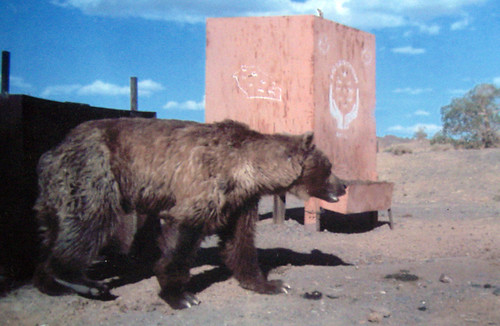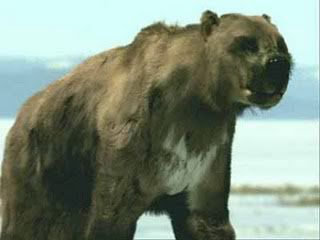Post by grrraaahhh on Jun 9, 2011 7:19:00 GMT -9
[img src="http://ilike.mn/billy/gobibear/images/stories/headerslider/slide1.jpg["]
Ursus Arctos Gobiensis [Kingdom: Animalia; Phylum: Chordata; Class: Mammalia; Order: Carnivora; Family: Ursidae; Genus: Ursus].
Mazaalai – this simple mongolian word means Gobi Bear who inhabits in the Gobi desert of Mongolia. No other place on the entire Earth is home for this rare specie of Bear. Its scientific name is Ursus Arctos Gobiensis. It’s listed in the Red Book of Mongolia with a status of VERY RARE. Mazaalai is near extinction & globally threatened bear.

Large and heavily built, but a little smaller than the brown bear.Dark to light brown fur, with light chest markings on some animals. short thick legs, large feet covered in hair, five toes with long powerful claws.Heavy head on a short thick neck. Ears are short and rounded.Very short tail.Body length:180-240 cm, height at the shoulder:90-150 cm, tail length:6-21 cm, hind foot length:13-30 cm, body weight:150-300 kg.

Biology & ecology characteristics
The Gobi bear shape is similar to brown bear, but, body is smaller with large head, wide chest, high wither, short tail, thick and stubby foot, small eyes, wide and truncated ears and powerful nails. Compared with other bear species the body shape of a gobi bear is relatively small.
Apparently, females become mature at the age of 3 and males at 5. A mature female gives birth to 1-2 cubs, in 2 years. So, an average a female will have 1.5 cubs at birth. There is no information about rearing, death, loss and deceases of young cubs.
The Gobi bear has been settled in rocky mountains of southern gobi Mongolian Altai, that belongs to Central Asian extreme dry desert zones, at the altitude of 1300-2500m above sea level, and will habitat near rarely found oasis’s.

Individuals forage in the dusty desert for the leaves and roots of plants such as wild rhubarb and bajunna, as well as consuming insects and lizards.
Habitat
The gobi has a dry extreme continental climate, with wind and dust storm in spring time, hot summer and precipitation in summer, only.
The yearly air temperature fluctuates from –37 till +40, and seasonal and daily air temperature fluctuates highly, as well. During spring time, sand and dust storm speed may reach 40 meters\second.

The Gobi bear have been distributed in the “A” part of Great Gobi strictly protected area located at the south western part Mongolia. The south eastern part of Gobi bear distribution goes along with border Gansu region of China. According to data from 2005, the southernmost distribution went to 42’34, northern to 43’25, western to 96’05 and eastern to 100’00. This area covers 18.000 square km (Mijiddorj, 2006). The gobi bear distributions fluctuation, subsequent to 1940, has been summed up, according to press datas of last 60 years. Between 1940-1970, population in the north part has became extinct completely, and the area has diminished to more then 2 times; from mid 1970s the distribution has remained stable but, in eastern part it expanded a bit and bears have been observed at their former habitat.

This relict population is believed to have become rare and isolated due to changing climatic conditions in the area. The population is thought to be relatively stable but its small size makes it particularly vulnerable to any chance event such as drought. Disturbance by people and livestock is also a threat, and cubs are at risk from predation by wolves.
By 2005, 25-30 bears (Mijiddorj, 2006) are estimated. Abovementioned facts have showed that gobi bear has been a rare animal, originally. On the other hand, it shows that reproduction of this species has been going on. Our conclusion has been matching with some scientists (Sokolov, Orlov and others, 1992, Shaller and others, 1993, McCarthy, 2000) claiming; the population of gobi bear in the past century has not exceeded 100 and most realistic number was around 50 individuals at a time.

The present protection, management and plans for future
From ancient times, the Gobi bear has lived in the remote south westernmost edge of the country, having relatively less human direct impacts, being isolated from them. But, due to the fact that; human have taking over natural springs and oasis’s; livestock that has taken pasture, Gobi bear has been pushed away from its fertile habitat and population has decreased and distributed area has became smaller.

Great Gobi strictly protected area has three internal zones such as; core zone, protection zone and limited zone. Main habitat of gobi bear has been found in core and protection zones the protected area. The nearest settlement to the gobi bear distributed area is a settlement based at “Ekhiin gol” oasis in the limited zone of protected area, that has more than 10 families and about 600 heads of livestock. Due to settlers operation, oasis’s natural restoration disrupted and ecosystem is deteriorating (Chimedregzen, 1998).
Under the direct leadership of Ministry of Nature and Environment, the administration of Great Gobi strictly protected area has been carrying out following activities; putting signposts around the protected area boundary, closing roads that crossed bear habitat by changing directions, introducing regulations of the protected area to local herders, carrying out public awareness programs, providing fodder for animals, furnishing natural springs & water points and making new water points, in order to improve water supply, etc.

Reference
gobibear.mn/
Save the Gobi Bear (March, 2003) www.gobibear.org/index.htm
mongolia.panda.org/en/
MOUNTAINS OF THE SNOW LEOPARD (1994. Graham Creelman)
Administrative note: While technical material for the Gobi bear has been obtained (but not organized - they are planned for the 'General' thread) the information produced by gobibear.mn/ was used. It constitutes the majority of material information used. IMO, there is no data substitute for local and regional information and IMHO gobibear.mn and their conservation efforts warrant maximum exposure and recognition.
Ursus Arctos Gobiensis [Kingdom: Animalia; Phylum: Chordata; Class: Mammalia; Order: Carnivora; Family: Ursidae; Genus: Ursus].
Mazaalai – this simple mongolian word means Gobi Bear who inhabits in the Gobi desert of Mongolia. No other place on the entire Earth is home for this rare specie of Bear. Its scientific name is Ursus Arctos Gobiensis. It’s listed in the Red Book of Mongolia with a status of VERY RARE. Mazaalai is near extinction & globally threatened bear.

Large and heavily built, but a little smaller than the brown bear.Dark to light brown fur, with light chest markings on some animals. short thick legs, large feet covered in hair, five toes with long powerful claws.Heavy head on a short thick neck. Ears are short and rounded.Very short tail.Body length:180-240 cm, height at the shoulder:90-150 cm, tail length:6-21 cm, hind foot length:13-30 cm, body weight:150-300 kg.

Biology & ecology characteristics
The Gobi bear shape is similar to brown bear, but, body is smaller with large head, wide chest, high wither, short tail, thick and stubby foot, small eyes, wide and truncated ears and powerful nails. Compared with other bear species the body shape of a gobi bear is relatively small.
Apparently, females become mature at the age of 3 and males at 5. A mature female gives birth to 1-2 cubs, in 2 years. So, an average a female will have 1.5 cubs at birth. There is no information about rearing, death, loss and deceases of young cubs.
The Gobi bear has been settled in rocky mountains of southern gobi Mongolian Altai, that belongs to Central Asian extreme dry desert zones, at the altitude of 1300-2500m above sea level, and will habitat near rarely found oasis’s.

Individuals forage in the dusty desert for the leaves and roots of plants such as wild rhubarb and bajunna, as well as consuming insects and lizards.
Habitat
The gobi has a dry extreme continental climate, with wind and dust storm in spring time, hot summer and precipitation in summer, only.
The yearly air temperature fluctuates from –37 till +40, and seasonal and daily air temperature fluctuates highly, as well. During spring time, sand and dust storm speed may reach 40 meters\second.

The Gobi bear have been distributed in the “A” part of Great Gobi strictly protected area located at the south western part Mongolia. The south eastern part of Gobi bear distribution goes along with border Gansu region of China. According to data from 2005, the southernmost distribution went to 42’34, northern to 43’25, western to 96’05 and eastern to 100’00. This area covers 18.000 square km (Mijiddorj, 2006). The gobi bear distributions fluctuation, subsequent to 1940, has been summed up, according to press datas of last 60 years. Between 1940-1970, population in the north part has became extinct completely, and the area has diminished to more then 2 times; from mid 1970s the distribution has remained stable but, in eastern part it expanded a bit and bears have been observed at their former habitat.

This relict population is believed to have become rare and isolated due to changing climatic conditions in the area. The population is thought to be relatively stable but its small size makes it particularly vulnerable to any chance event such as drought. Disturbance by people and livestock is also a threat, and cubs are at risk from predation by wolves.
By 2005, 25-30 bears (Mijiddorj, 2006) are estimated. Abovementioned facts have showed that gobi bear has been a rare animal, originally. On the other hand, it shows that reproduction of this species has been going on. Our conclusion has been matching with some scientists (Sokolov, Orlov and others, 1992, Shaller and others, 1993, McCarthy, 2000) claiming; the population of gobi bear in the past century has not exceeded 100 and most realistic number was around 50 individuals at a time.

The present protection, management and plans for future
From ancient times, the Gobi bear has lived in the remote south westernmost edge of the country, having relatively less human direct impacts, being isolated from them. But, due to the fact that; human have taking over natural springs and oasis’s; livestock that has taken pasture, Gobi bear has been pushed away from its fertile habitat and population has decreased and distributed area has became smaller.

Great Gobi strictly protected area has three internal zones such as; core zone, protection zone and limited zone. Main habitat of gobi bear has been found in core and protection zones the protected area. The nearest settlement to the gobi bear distributed area is a settlement based at “Ekhiin gol” oasis in the limited zone of protected area, that has more than 10 families and about 600 heads of livestock. Due to settlers operation, oasis’s natural restoration disrupted and ecosystem is deteriorating (Chimedregzen, 1998).
Under the direct leadership of Ministry of Nature and Environment, the administration of Great Gobi strictly protected area has been carrying out following activities; putting signposts around the protected area boundary, closing roads that crossed bear habitat by changing directions, introducing regulations of the protected area to local herders, carrying out public awareness programs, providing fodder for animals, furnishing natural springs & water points and making new water points, in order to improve water supply, etc.

Reference
gobibear.mn/
Save the Gobi Bear (March, 2003) www.gobibear.org/index.htm
mongolia.panda.org/en/
MOUNTAINS OF THE SNOW LEOPARD (1994. Graham Creelman)
Administrative note: While technical material for the Gobi bear has been obtained (but not organized - they are planned for the 'General' thread) the information produced by gobibear.mn/ was used. It constitutes the majority of material information used. IMO, there is no data substitute for local and regional information and IMHO gobibear.mn and their conservation efforts warrant maximum exposure and recognition.

